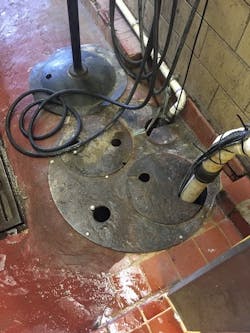A Fahrenheit Fix
James Ward is maintenance manager for United Dairy. Ron Keesee is support representative for Service Pump & Supply. Jay Gallagher is regional manager for BJM Pumps. Keith Grgurich is director of sales for BJM Pumps. Ward, Keesee, Gallagher and Grgurich can be reached by contacting Suzette Pascal at [email protected].
undefinedService Pump & Supply (SPS) has supported industrial equipment owners in the Ohio River Basin and Appalachia regions of the U.S. by providing pump and motor remanufacturing services since 1980. One of SPS’ five service centers, based in Huntington, W.Va., has a history of providing reliable service to the United Dairy plant in Charleston, W.Va. A function of the United Dairy facility is to bottle milk, which comes from family farms located within 100 miles of the United Dairy plant. The plant is known for selling high-quality milk that is free from antibiotics and artificial growth hormones.
Having a long-standing relationship with the United Dairy plant, SPS makes regular site visits to the facility. In February 2015, Ron Keesee, an SPS support representative, was visiting with James Ward, maintenance manager at the United Dairy plant. During their tour of the plant, Ward spoke with Keesee about frequent pump replacements for one of their wash down sumps.
Pump Upgrade
Each submersible pump that had been placed into the wash down sump only would work for three to six months before it needed to be replaced. Ward asked Keesee if there was a different pump United Dairy could use in the wash down sump that would be better suited for its high-temperature application.
The 3-ft-deep wash down sump in the roll receiving area collects wash down water. This wash down water is hot and contains chemicals used during the cleaning process. The cleaning process requires a cleaning solution to properly sanitize the tanks and trucks, followed by a clean water wash down using hot water heated to a maximum of 140°F. All the hot liquid from this cleaning process collects into the wash down sump.
During their conversation, Ward and Keesee discussed the major requirements for selecting a new submersible pump for the wash down sump.
Since the wash down water flowing into the sump consistently was at 140°F, the new submersible pump would have to handle high temperatures. Most submersible pumps cannot withstand pumping liquids at temperatures higher than 104°F, as this typically can cause motor failure. In this case, the hot liquid had been causing the previous pumps to regularly fail over a two-year period.
The submersible pump would need to handle any debris that might get into the wash down sump. While the wash down process usually sends liquids into the sump, occasionally mop strings or plastic tags also may get washed into the sump. It was important to select a pump that would keep operating, in case any solid materials unintentionally entered the sump.
Rising Temperatures
After his discussion with Ward, Keesee recommended a BJM Fahrenheit pump for the United Dairy plant’s wash down sump. Keesee reviewed features of the SK55CF Fahrenheit submersible shredder pump with Ward, showing how the SKF was designed to pump temperatures up to 200ºF and handle up to 3.5-in. solids. Keesee recommended the SKF pump for the wash down sump.
This pump shreds solids using a cutting impeller with a tungsten carbide tip, which allows the pump to rip apart solids against a tooth-edged spiral-shaped diffuser plate. With 360-degree shredding action and non-clog impellers, it would handle the solid materials that might enter the wash down sump during cleaning. Additionally, the pump is manufactured from hardened cast iron and has a 304 stainless steel motor housing for abrasion and corrosion resistance.
The pump’s motor is protected with double mechanical seals, which are comprised of a lower seal made of silicon carbide and upper seal faces made of carbon and ceramic. An additional lip seal is installed above the impeller to help prevent unwanted materials from entering the seal chamber.
Winding protection and Class R motor insulation allows the motor temperature to raise up to 220°F. An automatic switch turns the pump motor off if the temperature and/or amp draw raises too high. When the motor cools, the switch is designed to automatically reset and the pump will begin operating again.
It also has a seal minder moisture detection system, a sensor probe inside the oil chamber that can provide an early warning to protect the pump motor.
When the seal failure circuit or moisture detection circuit is properly connected to a control panel, it informs the pump operator that there is moisture within the oil chamber. This early warning can allow the operator to schedule repair and inspection on the pump.
Making A Decision
After reviewing the specs with Keesee, Ward decided to purchase the 7.5-hp submersible shredder pump.
“Buying new pumps every few months gets expensive, so I was determined to find the right pump for our sump and save our maintenance dollars by installing a more ‘heavy-duty’ submersible pump,” Ward said.
Ward’s in-house maintenance team installed the pump into the wash down sump, using a steel cable to suspend the pump into the 3-ft deep pit, elevating it only inches from the bottom of the sump.
Although there was a minor issue with the seal minder cable and control box, it was corrected and the submersible pump was back in operation quickly.
